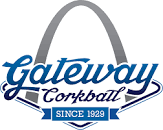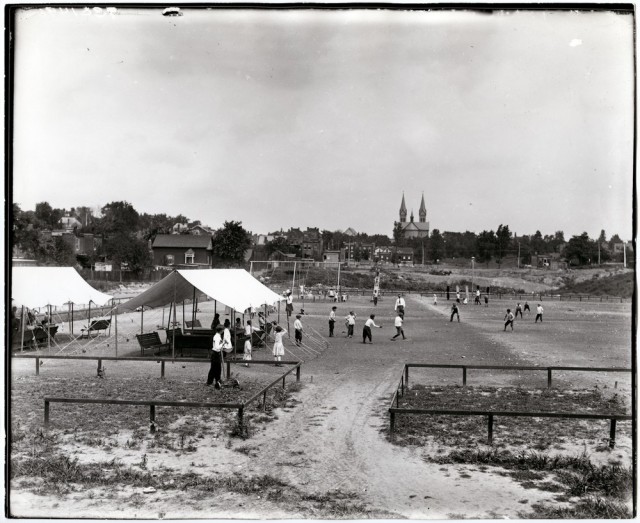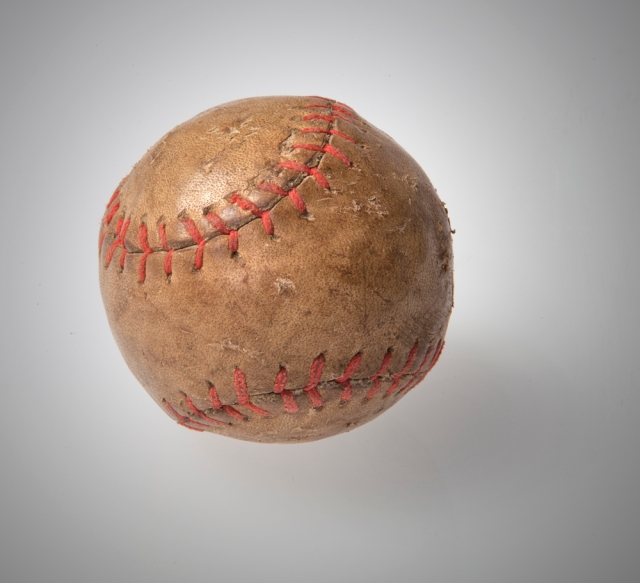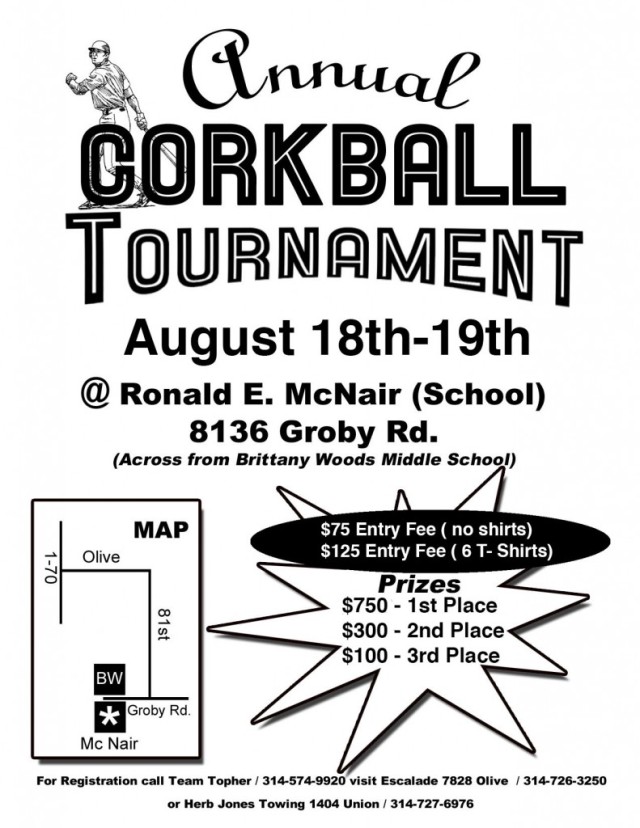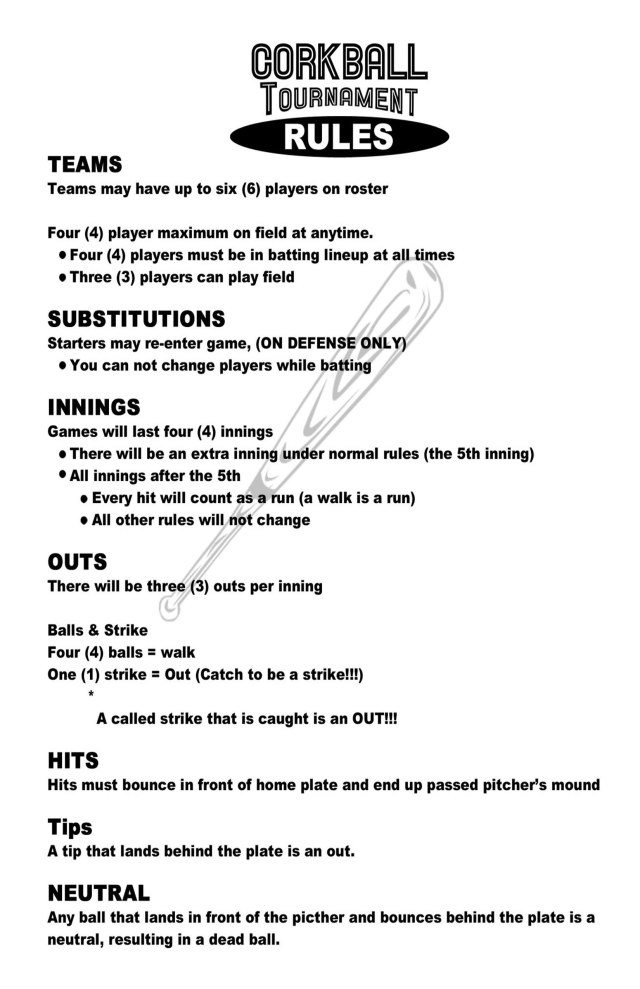Below is an article I wrote over the winter of 2012 about corkball that was supposed to be included in a new baseball journal put out by the St. Louis Baseball Historical Society. The journal’s future is now in doubt due to conflicts between the publisher and the ad agency responsible for publishing it, so I’ve decided to go ahead and publish it here. Enjoy!
St. Louis’ love for the sport of baseball cannot be denied. By all accounts, it has been played in some form or another in our city for more than 150 years, which is precisely why the St. Louis Baseball Historical Society was founded. Baseball’s roots run very deep here, and those roots have at times sprouted to reveal different forms of the game that may not be as popular or well known as the mother game.
One of these off-shoots of baseball is the game of corkball (or “cork ball” as it was originally written). Corkball is defined as a fast-pitch bat-and-ball (or “safe haven”) game. Bat-and-ball games are basically a much more primitive and simpler form of baseball that probably goes back centuries, or perhaps even thousands of years, as it essentially just involves hitting something small and round with a stick. It can be argued that people—children, mostly—have been hitting things with sticks for fun for millennia. But, as we know, this practice didn’t really get recognized as a sport and become organized as such until the middle portion of the 19th century. But when it finally did become organized, it didn’t take long for it to catch on like wildfire. Nor did it take long for variations of the game to appear in distant parts of the country. Stickball, for example, became very popular on the streets of New York City, Boston, Philadelphia, and elsewhere in the Northeastern U.S. Here in St. Louis, several games that are in some ways related to baseball began to emerge. Softball, obviously, has been played here in beer leagues for decades after first getting its start in Chicago in the 1880s. And, more recently, the former kids’ game of kickball—which got its start in Cincinnati—has gotten pretty huge (the “stick” in that game being one’s leg, naturally).
When I was growing up here in St. Louis, my father (who grew up in the ’20s and ’30s in Maplewood and North St. Louis) would tell me stories of playing “Indian ball” as a kid when he and his friends didn’t have enough players to field a full nine per side. They’d just play ball without the base running, using “ghost runners” instead of the real thing. He also described corkball and “bottle caps” to me (the latter being a variation of corkball where you simply replace the ball with a cap from a bottle), and I managed to amass a rather large collection of bottle caps for playing that—along with corkball and/or Indian ball—at family reunions back in the ’70s. I was unaware, however, of any actual “corkball clubs” in St. Louis until I started doing some investigative research into the game via the Internet about ten years ago. That’s when my eyes were opened to the game’s rich history in St. Louis, having found that the first of these clubs, Gateway, originated all the way back in 1929. I was floored!
Digging deeper still, I learned that the game’s history is almost as old as professional baseball in St. Louis itself! Apparently, it was first played at Mueller’s, a boarding house and saloon located at the corner of Grand & Greer on the city’s north side where the team’s owner, Chris Von der Ahe, was the saloonkeeper. The story goes that sometime in 1890, one of the Browns’ players pulled the bung out of a keg of beer, carved it into the shape of a ball, and began pitching it to a teammate using a broomstick as a bat, while three other players played behind him and another served as catcher. It probably didn’t take long (perhaps a few busted windows, pint glasses, and mirrors) before the game was relegated to cages that were erected adjacent to these establishments, of which there were many and in just about every part of town. As the years went by, players started organizing leagues, and, with that, actual manufactured “cork ball” equipment became commercially available thanks to a number of enterprising local sporting-goods manufacturers. No one is sure exactly how many companies produced “official cork balls,” as they all seemed to have been stamped, but we know some of these names include Rawlings, Wilson, Worth, Leacock, Sisler Hummel, Murson, Proline, Anchor, and, more recently, Markwort. R.H. Grady Company is credited as being the first to develop a horsehide-covered, stitched ball, which dates to 1920. And a few Major League ballplayers from the area are known to have played the game as kids, including Yogi Berra, Joe Garagiola, and Pete Reiser.
Despite its longevity and almost cult-like following in St. Louis, however, corkball hasn’t had much success spreading to other parts of the country. Oh, it’s happened, sure. There’s a club in Chicago, and I’ve also heard of outcroppings of games being played in several locations in Illinois, as well as Denver, Texas, California and in various spots in the South, including Jacksonville, Florida, where Butch Trucks and Duane Allman of the Allman Brothers Band are known to have played the game as kids. During World War II, Howard Rackley introduced the game to his fellow servicemen on the deck of the aircraft carrier Bunker Hill, which did a lot to disseminate the game to other parts of the country, as many of those guys brought the game home to their hometowns after the war. But lacking the history and cultural connections in those towns, it has struggled to survive, much less blossom and grow.
I quickly became intrigued by the game and its inherent connections in St. Louis and decided I wanted to do a couple of things. First, I wanted to play it! It had been over 30 years since I’d held a corkball in my hand—much less attempted to hit one with a stick—but I always considered myself a fairly decent ballplayer, so utilizing some social networking sites like Twitter and Facebook, I pulled together some friends to start playing some recreational games at the abandoned corkball fields located along Arsenal in Tower Grove Park. Secondly, I thought it would be a good idea to try and pull all of the information that I had found out about the sport together under one virtual roof and create a website, and thusly, this Corkball site was born. The site serves as a blog where I can share information about the sport, as well as provides plenty of information on its history, rules, where to purchase equipment, and even includes a discussion forum.
For me, recruiting enough people interested in playing the game recreationally week in and week out proved pretty challenging. While a lot of people may have heard of it—or are curious about it—it’s been quite a struggle to find a good core of players who are committed to keeping it active throughout the course of the spring and summer. Most of the players I was able to recruit were already participating in similar area sports, such as softball and fuzzball. Corkball’s appeal for softball players is that it equates to less wear and tear on one’s aging legs, and for fuzzball guys, who are used to swinging at the larger tennis balls, it means a bit more of a challenge. But it feels good to actually put the corkball fields at Tower Grove Park to use in their intended purpose. These fields used to be home to the Sportsman’s Corkball Club before they hightailed it to Jefferson Barracks Park in 2000, which they’ve shared with the South St. Louis Corkball Club ever since. The other two established St. Louis clubs are Lemay (established in 1947), which plays its games at the Santa Maria Knights of Columbus on Mt. Olive Road in South St. Louis County, and Gateway, which has its own clubhouse and fields on Walsh St. in the city’s Dutchtown neighborhood.
For those of you who may not be familiar with the corkball scene in St. Louis, there’s a culture surrounding the game that can be a bit hard to crack. While the established, older, and more competitive clubs often have open enrollment tryouts, it really helps if you know (or are related to) someone there first. But I believe it’s because of that close-knit culture and its (for lack of a better word) “cliquishness” that these clubs are seeing a dwindling interest in the sport, which equates to less participation. The guys who have been playing it the longest are getting older, and it’s not as easy to transfer the love of the game on to their children and their friends as it was in generations past when our youth had fewer distractions. Baseball, in general, has been experiencing similar issues.
When speaking with “Corkballman” Bob Young on the phone recently, I was able to get a little bit more history of corkball, especially in South St. Louis. Bob is the grandson of Don Young, who was known as “Mr. Corkball” for more than four decades and whose name adorns the tucked-away corkball playing fields at Jefferson Barracks Park. Don’s father, Bill, co-founded the Grupp (which later changed its name to South St. Louis) Corkball League in 1936. The Don Young Corkball Fields at JB Park are the nicest you’ll find anywhere, and they’re shared by both Sportsman’s and the South St. Louis Corkball Club, with the latter beginning play there in 1965. The cages of yesteryear, though, are all long gone. One of the last remaining corkball cages that I’m aware of was removed by owner James Russell from BJ’s Bar in Florissant after almost 30 years of use in 1985 and sold to the Ferguson Church of the Nazarene for $125.
I caught a tone of concern in Bob’s voice when I asked him about the future of the game. He told me that, at its inception back in the 1970s, their annual August tournament at Jefferson Barracks Park would include as many as 30 different teams. In recent years, they’ve been lucky to recruit teams from each of the “big four” St. Louis clubs. Corkball is need of a shot in the arm, a big boost that could help attract a new generation of young players forming their own teams and leagues and reverse the trend. Bob did remind me, though, that every Sunday afternoon throughout the spring and summer, they have pick-up games of corkball at Jefferson Barracks Park, and he stresses that ANYONE is welcome to come play, which is probably the easiest way for those curious about the sport to get involved.
There are quite a few culturally significant things that make St. Louis a pretty unique city. Everyone knows about Ted Drewes Frozen Custard, St. Louis-style pizza and barbecue, toasted ravioli, gooey butter cake, and, to a lesser extent, brain sandwiches, but as unique to St. Louis as the game of corkball is, it’s largely unknown here these days, and that’s a bit sad. Especially when you consider how popular the game obviously used to be. But, that being said, it’s still got a much larger level of participation here than in any other city in the country, and for that, we should be thankful.
JBK
